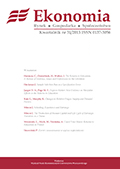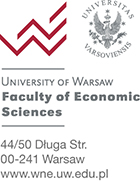Próba weryfikacji hipotezy Easterlina
M. Szlaga, P. Żukowski
ABSTRACT:
Full text (PDF)
Issue number: 21
In this issue:
Uspołecznienie rynku a proces globalizacji. Przypadek funduszy emerytalnych
A. Ząbkowicz
ABSTRACT |
PDF
The paper discusses the idea of socialized market, developed among others by Karl Polanyi and German ordoliberalism and institutionalized in the framework of the welfare state. The idea is eroding since labour interests, backed by the capitalist state have come under pressure of global business. Under globalized competition the welfare state seems to submit the idea of socialized market on behalf of the idea of free market. The European Union which is an association of national welfare states, paradoxically, seems to follow the economic liberalism (neoliberalism). Poland in spite of constitutional declaration on behalf of social market economy actually seems to undertake the UE drift. A study of pension funds has been undertaken in order to illustrate the trend observed, namely the shrinking of socialized sphere on behalf of the expansion of private global interests. The study refers to operations of so called second pillar of the pension system in Poland.
Kontraktowanie i koszty transakcyjne w partnerstwie publiczno-prywatnym. Ujęcie w świetle nowej ekonomii instytucjonalnej
L. Rojewski
ABSTRACT |
PDF
Public-private partnership (PPP) is one of the methods of financing and satisfying the public needs, while limiting the public sector's role to an indispensable minimum. Prior to making decision on carrying out a public task by the PPP method, the public sector is due to prove higher effectiveness of this method compared to the traditional financing method. The necessary process of long-lasting analyses and negotiations can lead to generation of transaction costs higher than in the case of the traditional model of financing. Till now, in the pertinent literature little attention has been paid to transactional costs related to the establishment and maintenance of the public-private partnership; hence the attempt at revealing the determinants of transactional costs inherent in the contracts realized under the PPP formula. ekonomia
Kapitał społeczny a instytucje - konceptualizacja i relacje
B. Łopaciuk-Gonczaryk
ABSTRACT |
PDF
The paper revises the most important definitions, categories and concepts of social capital and tries to achieve their synthesis. It compares the term social capital and the term institution (as understood by new institutional economics) and tries to show possible relations between social capital approach and institutional analysis. The first part discusses if it is proper to use social capital term, it shows critic on social capital approach and the defence, as well as the concept perspectives. The second part focuses on the search for common definition of social capital. It discusses the complexity and internal contradictions of social capital concept, that make the research difficult, and follows with some possible synthesis of the concept, including both social relations and the social norms accompanying them. The third part analyses connections between social capital and institutions. It shows that the terms social capital and informal institutions to some extent cover similar area of research and that there are important relations between social capital and formal institutions which themselves are not part of social capital. This part also shows areas where social capital researchers may benefit from new institutional economics and where social capital approach may help to develop economic theory.
Funkcjonalność modeli scoringowych i ratingowych w świetle implementacji nowych uregulowañ
B. Pawłowska
ABSTRACT |
PDF
The paper's intention is to present the functionality of the scoring and rating models approved by the New Capital Agreement and the Capital Requirements Directive in the context of credit risk management. The know-how transfers initiated the process of superseding the traditional credit risk assessment methods by new methods. The scoring and rating models are being successfully used by foreign banking institutions. A synthesis of views on credit risk assessment methods (credit scoring and credit rating) also results from many advantages that occur as well on the side of the banking institutions as on the side of their clients. The credit scoring and credit rating models automatize the banking credit procedures by providing an objective assessment of all the credit applications. In addition, standardized scoring and rating models reduce the costs related to the credit applications analysis. The existing interest in modem methods of credit risk quantification in the period of implementing the NCA/CRD inspired the author to formulate the thesis that the scoring and rating models would continue to enjoy interest on the part of the domestic banking institutions (i.e. co-operative banks). The complicated procedures of determining the capital adequacy prescribed by the CRD will make a stimulus to implementation of the models in question by the financial institutions that have hitherto been using traditional creditworthiness assessment methods, because the new methods simplify and accelerate the analysis of credit applications and have been included in the framework of admitted credit risk quantification methods for internal ratings. The universal functionality of scoring and rating makes the models more and more popular and demanded. In the long run, automation of processes and an elastic offer adapted to the client's profile will decide on the financial institution's competitive position. Wherever there is need for automatism and maximum objectiveness, the scoring- and rating-based assessment win most probably find new advocates.
Wpływ konsolidacji i koncentracji sektora bankowego na poziom cen w bankach. Przykład Stanów Zjednoczonych
S. Kozak
ABSTRACT |
PDF
Consolidation leads to the higher concentration of the banking sector. Developments of ICT and electronic banking, on the one hand enable to create extended banking organizations, but on the other hand expand boundaries of the local banking market and the range of banking products. This research, which was conducted on the group of top 50 US banks for the period of 1994–2005, shows that there is a positive, although weak, correlation between the banking market concentration and the price level. Moreover, the research indicates the level of non-interest costs, as an important determinant of the increase of lending interest rates. Factors responsible for the reduction of lending rates are: the value of banking assets, the value of non-interest earnings, and the level of development of local real and financial sectors. The general outcome of the research suggests that the analysis of market effects of the bank merger should not be focused only on the relationship between the banking market concentration and the level of prices, but on the feasibility of improvements in the cost and revenue structures, resulted from expansion of the bank's network and the range of services. Consolidation may lead to reduction of overhead costs and banking prices. However, too broad expansion, may be a source of unexpected costs and force banks to raise lending rates and service charges, limit their competitiveness and put threat on the stability of the future operations.
Kryzys walutowy w Meksyku w latach 1994–1995
K. Spirzewski
ABSTRACT |
PDF
The globalization processes being at present an object of broad scientific research date from a dozen or so years. The beginning of the 1990-ies was the period during which the capital flows were beginning to trespass the state frontiers to a larger and larger degree. Like in the majority of economic processes, two purely financial problems have been connected with this phenomenon: the profit and the risk. The profit is linked to the capital owners' search after interest rates higher than those offered by their domestic financial market. Whereas the second problem, unseparable from the former, concerns the diversification of the assets portfolio in possession at the given moment. The phenomenon of the transfrontier capital flows is particularly noticeable because of its strong impact on local financial markets in the economies of countries of emerging markets. This impact has a two-way character:
- favourable—by strongly promoting the development based on the inflow of large quantities of lacking capital;
- negative—by increasing the dependence of the economic development on the foreign capital and, consequently, making this development dependent on the attained macroeconomic indices or, more exactly, on the assessment of such indices arbitrarily made by international financial markets. Such assessments are being compared with the expected ones, e.g. to the expected exchange rate level. Then, there is always risk that non-fulfilled expectations will lead to oscillations as a result of which the monetary authorities will not keep to the earlier planned exchange rate levels [Obstfeld, 1994, s. 211].
The subject of this paper will be the negative consequences that accompany the international capital flows or, more exactly, the exchange crises of 1994–1998 related to the globalization process (see section 1). In section 2, the Mexican exchange crisis of 1994 will be discussed (see section 2), its sources will be presented, as well as the political and economic situation. In section 3, the scale of the economy breakdown, the situation of the banking sector and the remedial measures undertaken will be discussed. The remaining part of the paper is organized as follows: in section 4, an answer will be presented to the question: is it possible do foresee a crisis? The section is divided into a practical and a theoretical concept. Finally, in section 5 conclusions of general character are presented.
Jakość oferty polskich ośrodków narciarskich
D. Chudy-Hyski, K. Cieślikowski, M. Żemła
ABSTRACT |
PDF
Big popularity of skiing among citizens of lowland country such as Poland causes the surplus of the demand over the supply of skiing services, which is naturally fulfilled abroad. However, low product quality can also be responsible for growing number of Polish skiers choosing foreign slopes. If a ski resort is treated as a tourist destination of a special kind, its product quality has to be understood as both services quality and environment quality. The Kano method and the importance-performance scale were used to detect Silesian skiers' requirements and their perception of the product quality of Polish ski resorts. On the base of the conducted research it's possible to state that Silesian skiers prefer one day ski trips and are not interested in any additional services at destination including aprcs-ski offer, gastronomy and accommodation. Instead they expect high standard of lifts and slopes, low prices, easy access and low level of congestion. Especially the last feature is pointed as the major weakness of all Polish ski areas. Skiers also often complain about poor quality of ski lifts and too high prices. Good access seems to be the main strength of Polish resorts as well as their scenic beauty, but the second requirement is not among the most important. The observed gap between the skiers' requirements and the resorts' offers suggest necessity of some actions improving the quality of Polish ski resorts. Investments increasing capacity of ski areas seems to be unavoidable too. On the other hand described preferences make the Silesian market not profitable for local economies and marketing actions on remote markets generating longer stays should be taken by responsible entities. It's also reasonable to try to influence Silesian market to create new market behaviour.

